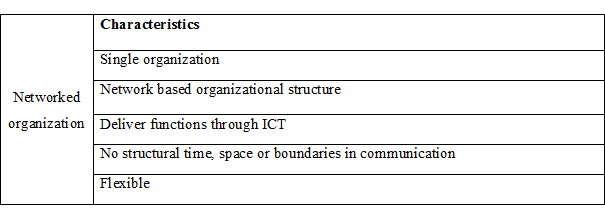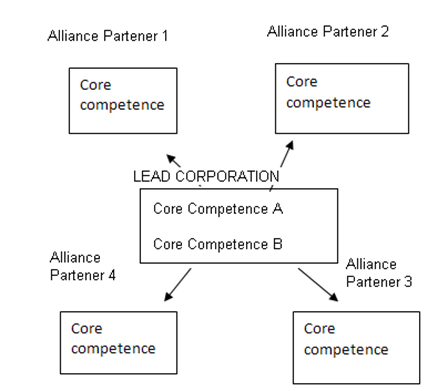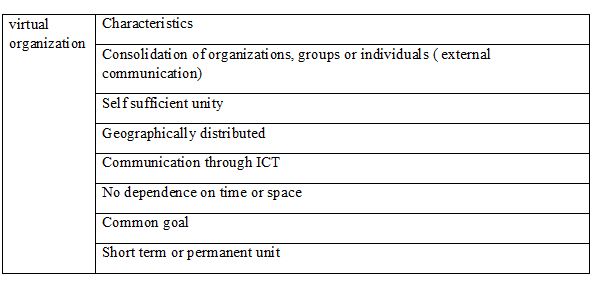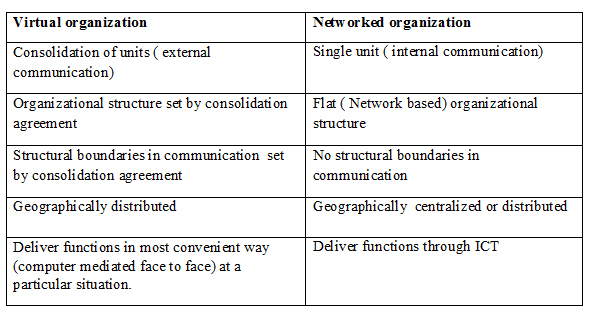Networked and Virtual Organizations (Organisational Behaviour and Design)
There is a lot of pressure on small and medium sized companies to become virtual organizations in contemporary business environment because it is changing at rapid rate. The unstable, dynamic environment in present situation causes recurrent changes of organizational structures and results in companies continually seeking the optimal model of the organizational arrangement. Consequently, it is essential for the companies to develop appropriate organizational structure and information network, which focuses on all information and resources critical for strategic and operational decisions. Companies are moving away from hierarchies to networks and from centralized to decentralized structures. Many management scholars, like Vetschera (1997) denoted to "VO" and "NO'' as synonym to the same type of organization. NO, sometimes called collaborative NO (Tramontin Jr., 2010; Camarinha-Matos et al, 2009), networked company (Bednar and Godkin, 2009), networked firm (Child, 1997), networked corporation (Smirch and Morgan, 1982), networked enterprises (Castells, 1996) and VO, sometimes called virtual enterprise (Martins et al, 2004), virtual firm (Mikolas and Wozniakova, 2009), are two of separate possible innovative solutions to the task arising to modern management setup.
Network organizations are basically described as small and medium-sized companies that manage themselves and converse and harmonize their work through face-to-face communication, telephone, post and fax. The concept of a network means nodes and links. The nodes can be people, teams or even organizations networks operate at many levels. Some examples are distributed geographic teams in large organizations, or small organizations operating as networks to compete against large corporations. The links are the various coordination and "agreement" mechanisms (Hastings, 1993). Jacobsen and Thorsvik (1998) stated that many organizations are less self-supporting of resources and must collaborate with other companies to accomplish their objectives. The capability to create a network by collaboration organization is need for companies to gain competition advantage. A network organization recognizes an individual's place in the organizational hierarchy. Formal communication assists descending transmission of orders and increasing transmission of information. Work rotates around a particular job description that takes place in a particular space, such as office in a particular building, street, town or state. The reward system is based on permanence. Dalsgaard and Bendix (1998) said that within all forms of network, people can't spare, in good or bad, mutual contact since they are dependent of each other. In management literature NO is described as an organization, or organizational field, all of whose members are connected to a single electronic network through which they communicate (sometimes on non-work affairs) and by means of which they access or provide information(Sproull and Kiesler, 1991). These organizations have communication rich environments, with information flows blurring traditional intra-company boundaries (Rockart and Short, 1991). Their communication structures are based on electronic networks where information flows flexibly and spans groups and organizational boundaries (Miles and Snow 1992). Network organizations have a computer-mediated communication system expanded by acquisition and then reformed in integrated conjunction with its neighbors in other countries. (Lea, 1995).Rockart and Short (1991) exemplify a network organization by shared properties, goals, expertise, work, decision making, prioritization of timing and issues, responsibility, accountability and trust, recognition and reward.
Characteristics of network organization
The network characterizes a flexible structure that permits companies to survive in competitive environment. It develops relationships of co-operation among the new associates. Within the network structure the borders between structural parts are not as direct as in other forms of organizational structures. However, the process receives additional impulses through shared use of the information infrastructure and information networks, which are the common property of the network.
Virtual organizations have importance in business world because there are numerous challenges for doing business for the management of work processes and practices such as new products, the globalization and internalization of businesses. The development of the Information and Communication Technology (ICT) facilitated a decentralization of work and created pressures for new organizational structures and job contents. Future mobile and wireless technologies will transform the working life entirely by increasing possibilities to work whenever in any place. It is apparent that organizations in both the private and public sector have to transform themselves to completely exploit these new technologies in order to survive in the temporally compacted world. Such factors led to emergence of the number of virtual organizations. The globalization of economies and businesses augments the number of enterprises without boundaries, creating multi-site working in cross-cultural contexts. To fully adapt in these changes, businesses must organize themselves along fundamental new lines (Vartiainen, 1991). Additionally, Jarvenpaa and Leidner (1998) said that when companies expand internationally, face increasing time compression in product development, and use more foreign-based subcontracting labour, virtual organizations assure the flexibility, responsiveness, lower cost, and improved resource utilization necessary to meet changing task requirements in a extremely disordered and dynamic international business environment. Technical modernization in the competence of computing and telecommunications technologies have facilitated virtual organizations to obtain and maintain distributed structures by supporting coordination among people working from different locations. Ray Grenier and George Metes argued the change to this new organizational structure as a response to unparalleled customer expectations and alternatives, global competition, time compression, complexity, rapid change, and better use of technology. They explained the virtual model as a lead organization that makes coalitions with groups and individuals from different organizations that have good potential to develop a specific product or service in a short period of time. Grenier and Meters also described that such coalitions are virtual because products and services are not produced in a single corporation whose purpose is prolonged existence. These new virtual organizations comprises of a hybrid of groups and individuals from several companies that include customers, competitors, and suppliers who have a specific objectives to develop a high-quality product or service to market as quickly as possible.
The virtual cooperation. A network of organization working independently to bring product in the market.
Theoretical studies have been done to recognize virtual organizations. Ahuja and Carley (1998) stated that a virtual organization is a geographically distributed organization whose members are bound by a long-term common interest or goal, and who correspond and coordinate their work through information technology. Other theorists define virtual organizations, as a small, core organization that outsources major business functions. In structural terms, the virtual organization is highly centralized, with little or no departmentalization (Robbins, 2001). Jackson explained virtual organizations from a very technical perspective (1999). The term virtuality was first invented in the area of information technology in which it was used to illustrate memory that could be activated only for a particular purpose. With such task specificity it is possible to make computer memory appear bigger than it is in reality. This concept was applied to organizations to maintain a similar fact, this being organizational structures and processes that do only exist when activated. Consequently, virtual organizations emerge big on the outside, while being small on the inside. This is possible with the extensive use of computer-mediated networks. Some group of theorists stated that Virtual organizations are dynamic networks of knots (individuals, organizational sub-units, organizations) whose (computer-mediated) links are configured dynamically and only for specific problems (Picot etal. in Jackson, 1999). Therefore, virtual organizations are characterized by a steady process of determining and re-shaping (Barnatt; Davidow and Malone; in Jackson, 1999). Ahuja and Carley (1998); Daniels (1998); Jarvenpaa and Leidner (1998) have recommended that ICT are the vital "organizational bond" that embrace the virtual organization together although it is geographically dispersed.
Characteristics of a Virtual Organization
The common characteristics of virtual organizations include a purpose that is motivated by specific market opportunities, world-class core competence, information networks, interdependent relationships, and permeable boundaries. Virtual organizations correspond to structures that are encouraged by particular market opportunities. Once the association has been developed and the opportunity has been exploited, collaborators may come forward to new partnerships and alliances. Each associate in a virtual corporation contributes a high level core competence, such as design, manufacturing, or marketing. This ability of multiple firms to create synergies among world-class functions and processes creates innumerable possibilities. As organizations form these new linkages, highly developed information technology becomes an important component and the major ground for the success of a virtual organization. Computerized information systems permit workers from geographically dispersed locations to link up with one another.
The virtual office may utilize desktop videoconferencing, combined software, and intranet systems to improve the flow of information among team members. Besides the requirement for immediate communication with one another, members of these independent virtual teams have increasing requirements regarding the amount and quality of information they need to do their work. Members of the virtual organization, develop a network of mutually dependent relationships. These relationships necessitate firms to be more dependent on one another than they have been in the past, demanding unparalleled levels of faith. Strong interdependencies cause organizations' boundaries to be unclear as competitors, suppliers, and customers enter into supportive agreements. These new relationships among companies force organizations to use new management practices.
Characteristics of virtual organization
Challenges
Virtual organizations are highly complex and challenging. Major challenges of the virtual organization include strategic planning dilemmas, boundary blurring, a loss of control, and a need for new managerial proficiency. Strategic planning also exert new challenges as virtual organizations determine effective combinations of core competencies. General vision among collaborators is prototypical to cooperating firms. When focused on a general goal, companies develop strong interdependencies that create problems to determine where one company ends and another starts. The boundary-blurring demands that these boundaries be managed efficiently. Coordinating mechanisms are crucial elements for supporting these loose collections of firms.
Sometimes, virtual structures make a loss of control over some operations. This loss of control necessitates communication, organization, and trust among the various collaborators, as well as a new set of managerial skilfulness. Workers are exposed to increased uncertainty about organizational membership, job roles and responsibilities, career paths, and superior-subordinate relationships. This vagueness requires for management to rethink about rewards, benefits, employee development, recruitment and other employee-related problems. It is quite difficult to develop leaders who are able to create and maintain these organizational forms. Management scholar, Les Pang presents numerous best practices, based on a review of successful implementations of virtual organizations. These are as follows:
- Promote cooperation, trust and empowerment.
- Make certain each collaborator contributes and identifiable strength or asset.
- Guarantee skills and competencies are complementary, not overlapping.
- Ensure partners are flexible.
- Ensure contractual agreements are clear and specific on roles and deliverables.
- If possible, do not replace face-to-face interaction entirely.
- Provide training that is critical to team success.
- Recognize that it takes time to develop the team.
- Ensure that technology is compatible and reliable.
- Provide technical assistance that is competent and available.
Future of Virtual Organizations
The business environment in present scenario necessitates firms to become even supplier, more agile, and to bring products and services to market at rapid pace. It is shown in management literature that traditional organization forms are not suitable to retain the needs of this persistent pace. New forms of organizing, such as the virtual organization, hold promise as organizational leaders experiment and learn novel strategies to manage in the twenty-first century. These new structures will require managers and leaders to deal with emerging challenges as they go into an environment of increased ambiguity and instability.
In scientific literature review, it has been demonstrated that investigators see the difference between VO and NO. As both types of organizations are directly related to computer mediated processes of relationship expression, yet they include few drivers' features.

The Use of Virtual Organizations
Virtual organizations are authorized in many countries of the world. The push of this effort is UK Gateway, a web portal that will permit citizens and businesses to carry out all official transactions online. The purpose of making all government services digital is a determined one by world standards and the UK will hit its target. Records indicated that in the United Kingdom today, 57 percent of the population of 60 million people have access to the Internet, and 98 percent of the country's three million businesses are connected. Many organizations and governmental agencies have formed virtual organizations.
To summarize, there are two types of organization in promising business environment. Virtual organization is an independent geographically distributed short time or permanent consolidation of organizations, groups or individuals, which without time or space hindrances correspond through ICT while accomplishing a common objective. On the other hand, Networked organization is a malleable organization with a network based structure in which employees without structural, time or space hindrances converse through ICT while executing their duties. A network organization is a set of independent firms or units that behave as a single big unit, using social mechanisms for harmonization and control. The entities that make up a network organization are generally lawfully independent entities but not always. Main features to differentiate virtual organization and networked organization are the position of the network in communication and function delivery process and number of organizational units involved.

